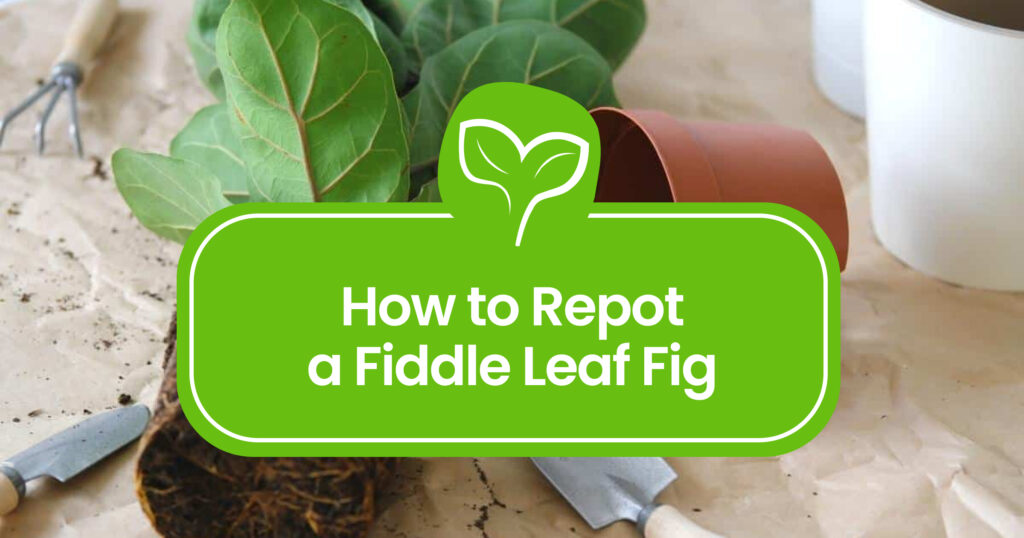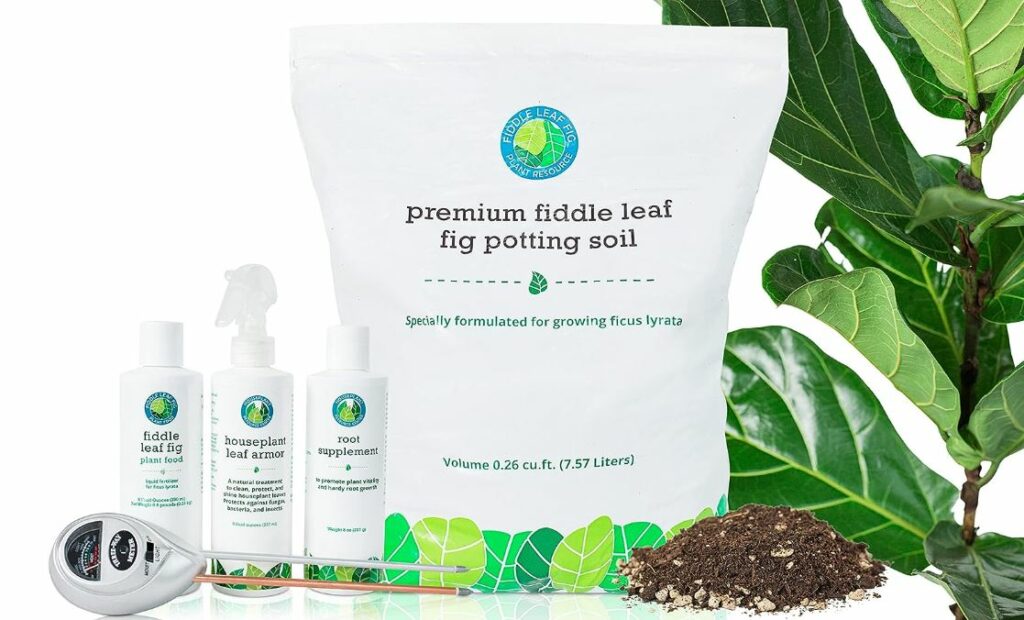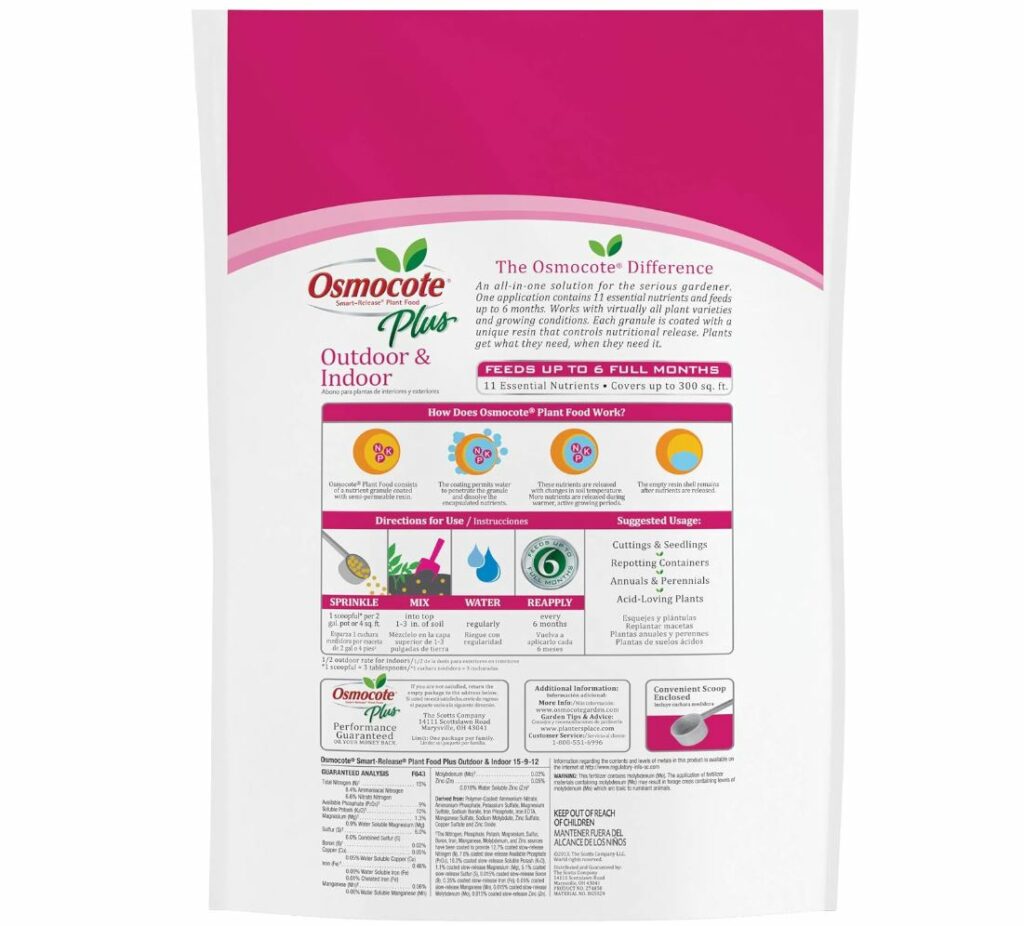
Today, we’re answering your question of How to Repot a Fiddle Leaf Fig, that lush, leafy friend that’s been brightening up your space. If you just brought your plant home from the store, you better get to it right away, because those containers are usually not designed for long-term healthy growth.
In this guide, we’ll walk you through every step in a friendly, casual manner. From choosing the right container and soil to mastering the repotting process and even ensuring your Fiddle Leaf Fig thrives post-transplant, we’ve got you covered. So, grab your gardening gloves, and let’s get our hands dirty!
How to know when to Repot a Fiddle Leaf Fig?
How do you know when it’s time to give your Fiddle Leaf Fig a bigger home? Well, it’s all about those roots!
Take a peek at the pot’s bottom – if you spot roots sneaking out through the drainage holes or find them huddled in a tight circle when you gently ease the plant out, it’s a clear sign your fig is yearning for more space. When that happens, it’s time to consider a slightly roomier pot, just a few inches larger, to accommodate your growing green companion.
The Tools You’ll need
Before you embark on this repotting adventure, make sure you have the right tools on hand:
- Gloves: Protecting your hands is always a good idea.
- Pruning Shears: You may need to trim the roots or prune your Fiddle Leaf Fig during the process.
- Trowel or Spade: Essential for digging and scooping soil.
- Container with Drainage Holes: We’ll get back to this, but it’s crucial!
- Potting Soil: Go for peat-based, well-draining soil with high organic matter.

Choosing the Right Container
First things first: You need the perfect pot for your Fiddle Leaf Fig’s new home. When choosing a container, consider the following:
- Size Matters: Opt for a pot that’s 2-4 inches larger in diameter than the current one. This provides room for growth without overwhelming your plant.
- Drainage is Key: Ensure the pot has drainage holes to prevent root rot. You can always place a saucer underneath to catch excess water. Avoid pretty pots without drainage holes at all costs!
- Material Matters: Terracotta, ceramic, or plastic? Each has its pros and cons. Terracotta allows for better airflow but dries out quickly, while plastic retains moisture but can be less breathable.
Choosing the Right Soil
Now, let’s talk soil. Your Fiddle Leaf Fig deserves a mix that promotes healthy growth and drainage. Look for a well-balanced potting mix with the following characteristics:
- well draining
- high in organic matter
- peat-based with some perlite
This Fiddle Leaf fig Care pack with Special Potting mix is actually pretty good.

How to Repot a Fiddle Leaf Fig Step-by-Step
Let’s dive into the nitty-gritty of repotting your Fiddle Leaf Fig:
- Add Fresh Soil to your New Pot: Place a layer of fresh potting mix at the bottom of the new pot. About 4 inches should do it for starters.
- Gently Remove the Plant: Carefully slide the Fiddle Leaf Fig out of its current pot. If it’s stuck, tap the sides of the pot or use a trowel to loosen the soil. If it is still not moving, you might need to cut into the old container.
- Inspect the Roots: Check for any unhealthy or rotting roots. Trim them if necessary. If your plant is fresh from the store, this probably won’t be a problem and you can just skip to the next step. If you want to get deeper into pruning your Fiddle Leaf Fig, check out our full guide!
- Position Your Plant: Center the Fiddle Leaf Fig in its new home, making sure it’s at the same depth as before.
- Fill in with Soil: Gently pack soil around the plant, leaving an inch or two at the top for watering.
- Water Thoroughly: Give your freshly potted friend a good drink and let excess water drain.
Fertilizing your Fiddle Leaf Fig after Repotting
Your newly repotted Fiddle Leaf Fig will appreciate some extra TLC in the form of fertilizer. You should do the fertilizing after about a month of repotting, and there are two main types to consider:
- Slow-Release Fertilizer: These pellets or granules release nutrients gradually over time, providing a steady supply for your plant. But you can just follow the package instructions for the application. We’d recommend these slow-release fertilizers for your fiddle leaf fig.
- Quick-Release Fertilizer: To apply a fast-acting water-soluble fertilizer, dissolve it in water and generously water your Fiddle Leaf Fig. Prioritize saturating the soil beforehand to retain the fertilizer in the pot longer, preventing it from quickly draining out and reducing the risk of fertilizer burn.

To sum it up
Congratulations, you’ve successfully given your Fiddle Leaf Fig a fresh start! Repotting might seem like a daunting task, but with the right container, soil, and a little know-how, you can ensure your leafy friend thrives in its new home. Remember to monitor your plant’s progress and adjust care as needed. Happy gardening, and may your Fiddle Leaf Fig grow taller and leafier than ever before!
Frequently Asked Questions
Typically, plan to repot it every 1-2 years. But what if you’d rather not go bigger with the pot? Well, for larger plants, there’s another trick up your sleeve: gently trim the root ball and pop it back into its old pot, with a fresh batch of potting soil to keep it cozy and thriving. That way, you can keep your fig happy without making it feel too cramped!
Do fiddle leaf figs like to be root bound?
These plants generally like to be a bit root-bound, but if you see any signs of hindered growth, it is possibly time for repotting.
Do fiddle leaf figs need big pots?
Too big pots can lead to root rot. Go for a new pot that’s just 2-4 inches larger in diameter than your current one. This way, you’ll strike the perfect balance between space and root health.
Can I use fertilizer after repotting my fiddle leaf fig?
Your newly repotted Fiddle Leaf Fig will appreciate some extra TLC in the form of fertilizer. You should do the fertilizing after about a month of repotting.

